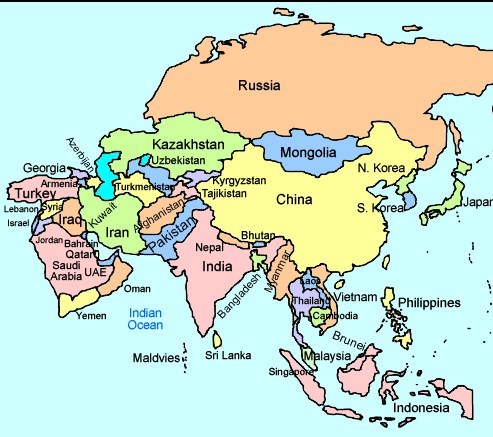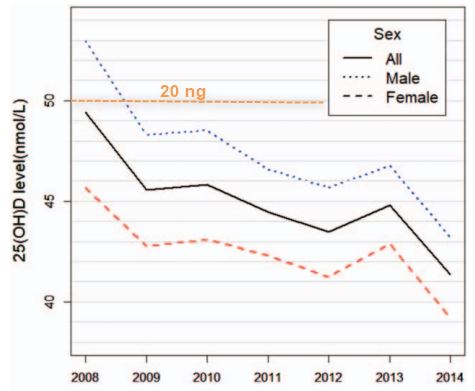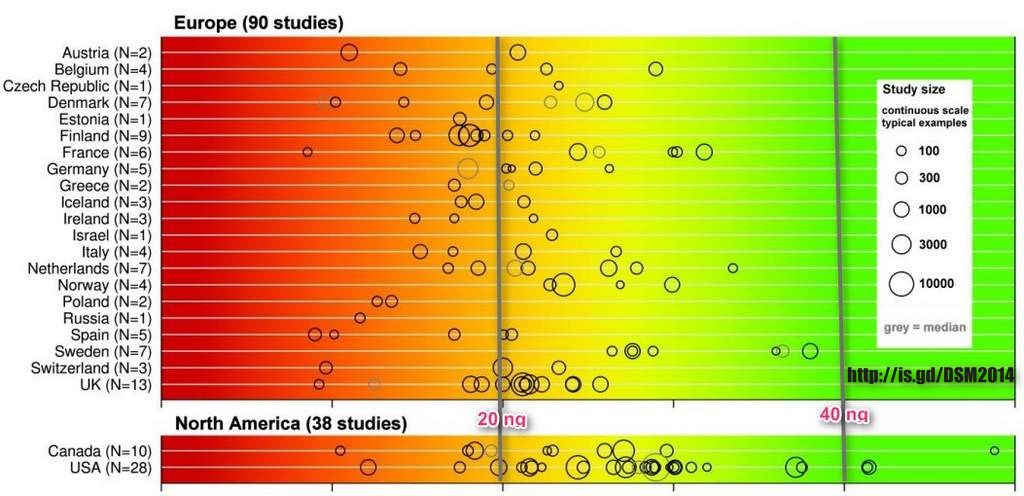Vitamin D levels from lowest to highest: Middle East, China. India, S EU. N EU
From: Vitamin D status in Africa is worse than in other continents
Lancet Glob Health. 2019 Nov 27. pii: S2214-109X(19)30492-9. doi: 10.1016/S2214-109X(19)30492-9.
Bouillon R1. 📄 Download the PDF from Vitamin D Life
Following table includes information from the table in the PDF
| Report | Location | <10 or 12 ng | <20 ng |
| Arabi et al (2010) 9 | Iran and Jordan | 50%✻ ✻ | 90%✻ ✻ |
| Zhang et al (2013) 5 | China | ~ 37% | ~ 72% |
| Web 2018 | India | - | 56% |
| Cashman et al (2016) 8 | EU countries (adults) | 13% | 40% |
| Mogire et al (2019) 6 | African continent | 18% | 34% |
| Hilger et al (2014) 2 | Global | 7%✻ | 37%✻ |
| Herrick et al (2019) 7 | USA | 5% | 18% |
✻ % deficient globally is probably higher. - Appears that the population size was ignored - see reference #2 below
✻ ✻ Middle East: has dark skin and air conditioning - staying out ot extreme summer heat ==> colds in the sunner
It appears that Asia has far lower average vitamin D levels than Africa ( as well 3.7X more population)

 * Vitamin D levels have been crashing
* Vitamin D levels have been crashing  * Click on chart for details* Vitamin D levels continue to fall in Korea– June 2018*
* Click on chart for details* Vitamin D levels continue to fall in Korea– June 2018*  --- 1. Overview Deficiency of vitamin D has the following
--- 1. Overview Deficiency of vitamin D has the following * Vitamin D levels around the world - DSM review June 2014 which has the following
* Vitamin D levels around the world - DSM review June 2014 which has the following
 --- 1. # In addition: Some groups are at higher risk of having low vitamin D* Obese Seniors Dark Skin Pregnant Shut-in Recent Trauma or surgery
--- 1. # In addition: Some groups are at higher risk of having low vitamin D* Obese Seniors Dark Skin Pregnant Shut-in Recent Trauma or surgery📄 Download the PDF from Vitamin D Life
References (most of which are in Vitamin D Life)
Bouillon R. Comparative analysis of nutritional guidelines for vitamin D. Nat Rev Endocrinol 2017; 13: 466-79.
Hilger J, Friedel A, Herr R, et al. A systematic review of vitamin D status in populations worldwide. Br J Nutr 2014; 111: 23-45.
Note: Probably lower global, as the results do not appear to be weighted by population size, thus China got the same weight as Belguim
Durazo-Arvizu RA, Camacho P, Bovet P, et al. 25-hydroxyvitamin D in African-origin populations at varying latitudes challenges the construct of a physiologic norm. Am J Clin Nutr 2014; 100: 908-14.
Lips P, Cashman KD, Lamberg-Allardt C, et al. Current vitamin D status in European and Middle East countries and strategies to prevent vitamin D deficiency: a position statement of the European Calcified Tissue Society. Eur J Endocrinol 2019; 180: 23-54.
<20 ng: in <20% of N Europe,in 30–60% in W, E, S Europe; up to 80% in Middle East
Zhang W, Stoecklin E, Eggersdorfer M. A glimpse of vitamin D status in Mainland China. Nutrition 2013; 29: 953-57
Mogire RM, Mutua A, Kimita W, et al. Prevalence of vitamin D deficiency in Africa: a systematic review and meta-analysis. Lancet Glob Health 2019; published online Nov 27. https://doi.org/10.1016/S2214-109X(19)30457-7
Herrick KA, Storandt RJ, Afful J, et al. Vitamin D status in the United States, 2011-2014. Am J Clin Nutr 2019; 110: 150-57
Cashman KD, Dowling KG, Skrabakova Z, et al. Vitamin D deficiency in Europe: pandemic? Am J Clin Nutr 2016; 103: 1033-44.
Arabi A, El Rassi R, El-Hajj Fuleihan G. Hypovitaminosis D in developing countries: prevalence, risk factors and outcomes. Nat Rev Endocrinol 2010; 6: 550-61.
Luxwolda MF, Kuipers RS, Kema IP, van der Veer E, Dijck-Brouwer DA, Muskiet FA. Vitamin D status indicators in indigenous populations in East Africa. Eur J Nutr 2013; 52: 1115-25.
Bouillon R, Marcocci C, Carmeliet G, et al. Skeletal and extraskeletal actions of vitamin D: current evidence and outstanding questions. Endocr Rev 2019; 40: 1109-51.
Hess AF. Rickets, including osteomalacia and tetany. Philadelphia, PA: Lea & Febiger, 1929.
Creo AL, Thacher TD, Pettifor JM, Strand MA, Fischer PR. Nutritional rickets around the world: an update. Paediatr Int Child Health 2017; 37: 84-98.
Title revision of March 2020 caused the visitor count to reset.
There have actually been visitors to this page since it was originally made
